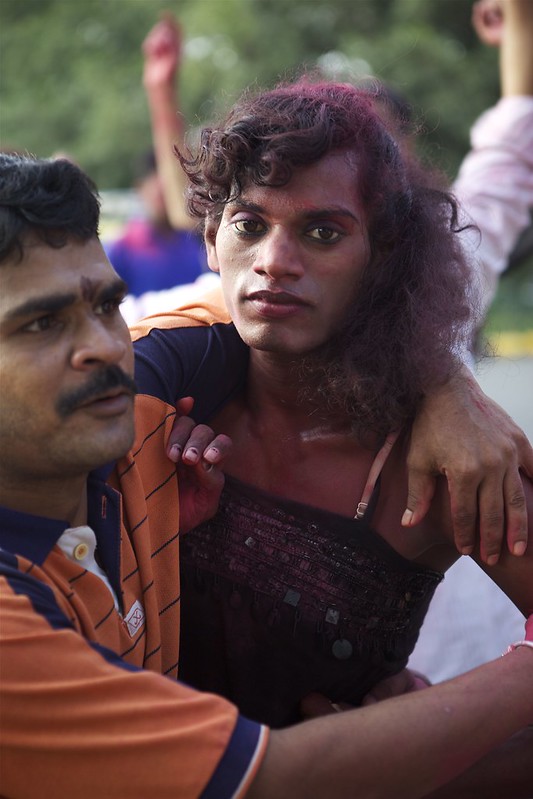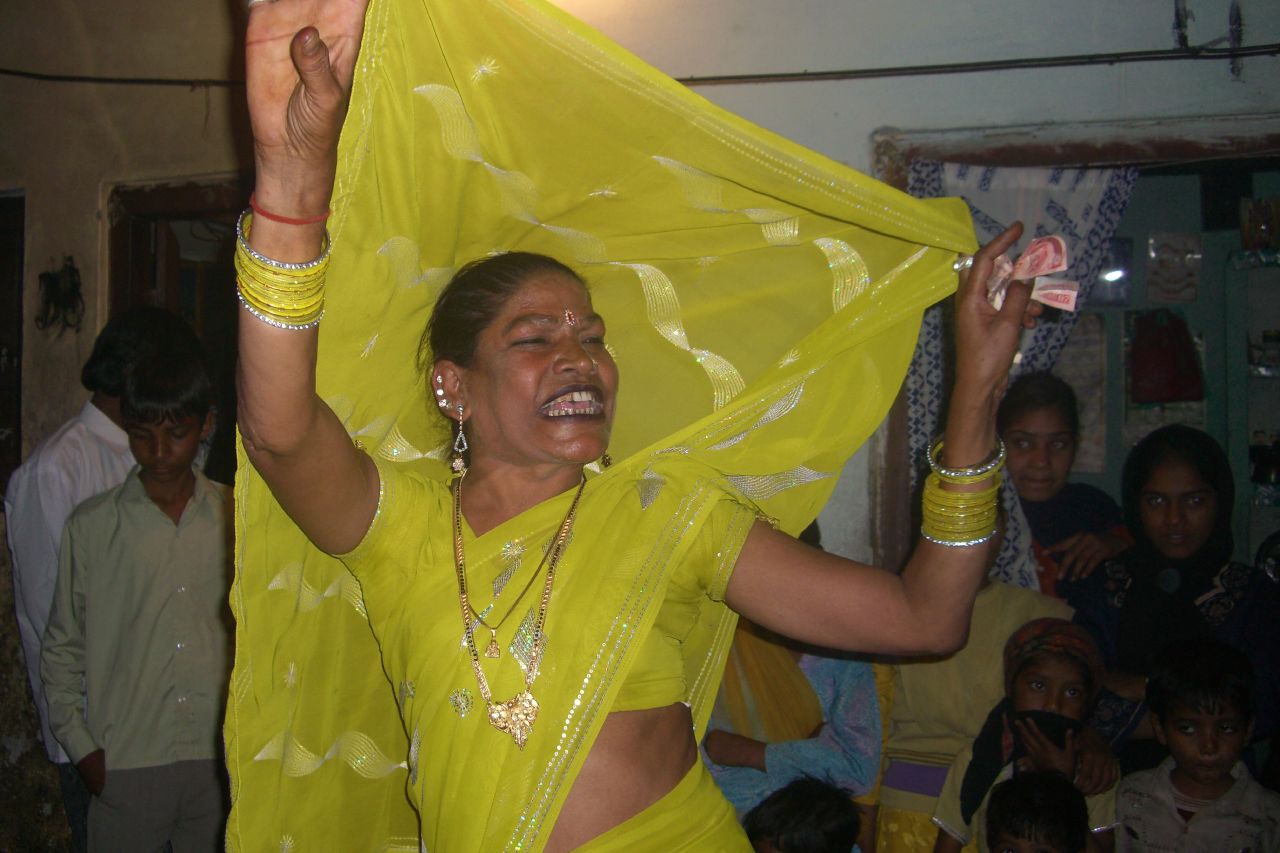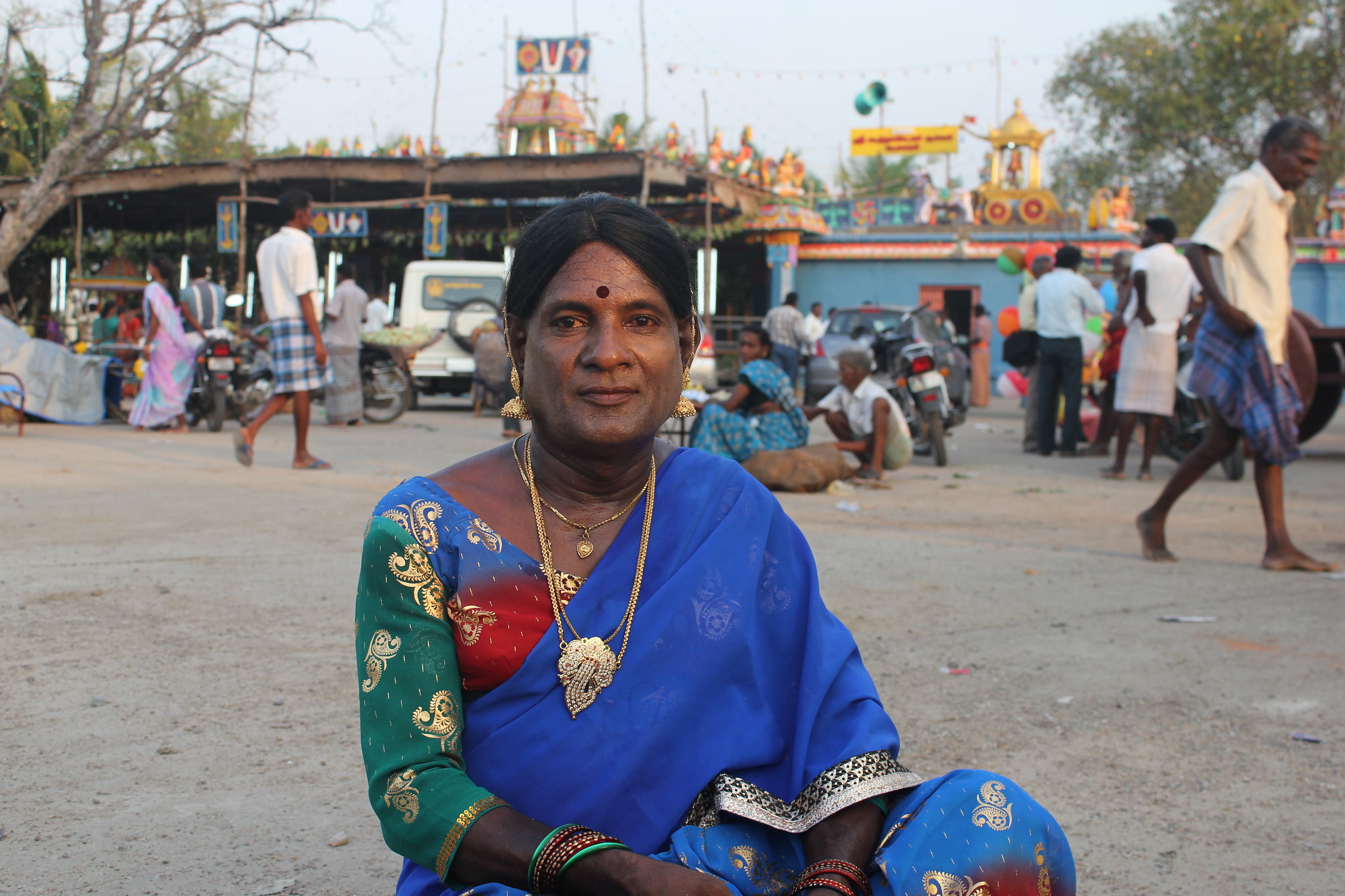The Role of Religion in Hijras' Lives

Hijras in Laxman Jhula (c) Daniel LofredoRota, CC BY-NC-SA 2.0 DEED
"It was my desire to transition into female and to live with hijra, to wear women’s clothes 24 hours, and these all have been fulfilled; so, I like it."
Roop, a 26-year-old hijra of the Chaklawala gharana (a congregation) in Mumbai, India, discussing experiences with gender transitioning services, such as breast implants, hormonal therapy and surgery, in Srivastava and colleagues’ 2021 study on hijras’ mental health and gender transitioning experiences [1].
Hijras are feminine individuals (assigned male at birth) within South Asian countries, such as Bangladesh, India, Nepal, and Pakistan, who worship the Hindu goddess Bahuchara Mata [2,3]. Hijras see themselves as similar to women. They typically wear traditional women’s clothing, use feminine names, shave facial and body hair, and grow their hair long. Some hijras may also go through hormonal therapy and/or cosmetic surgeries to achieve physical feminine traits. However, hijras also engage in behaviours untraditional to South Asian women, including the use of vulgar language and dressing in traditional masculine clothing on some special occasions [2].

Hijra (c) Frank Boyd, CC BY-NC-SA 2.0 DEED
Within hijra communities, there are different congregations called gharanas, which each have unique norms, religious practices, and relationship arrangements between hijras of a gharana [1]. Gharanas are ranked in a hierarchy to maintain social order. This means that hijras in different gharanas have different social rankings [4]. Furthermore, there is also a hierarchy within gharanas, where chelas’ (junior hijras) roles and responsibilities are assigned by gurus (teacher/leader hijras) [2,3]. To become a hijra, one must find a guru who will take them in and teach them hijra community norms, culture, and customs [4,5]. Within this process of becoming a hijra, many, not all, also go through a castration ceremony. This is where hijras’ genitals are removed as a sacrifice to the Hindu goddess Bahuchara Mata. In return, hijras are given great religious power, with the ability to bless and curse someone’s fertility and/or prosperity [2,3].

Hijra dancing in Delhi (c) Whitney Lauren, CC BY 2.0 DEED
As a result, hijras are often present at births, marriages, and other life celebrations, where they perform dances, songs, and badhai (blessings) for money. However, this demand for hijras’ blessings during life events has declined as South Asian cultures become more modern and less religious [5]. In addition, in recent decades, public respect for them as important religious figures has decreased [2]. Furthermore, hijras are discriminated against within employment and education outside of their religious roles [5]. Thus, hijras are forced to turn to more risky sources of income to survive, such as begging on trains, sex work, and threatening to curse births or weddings for money, which leaves them vulnerable and further ostracised by society and police [1,5]. Such unstable work also leaves hijras in poverty [5].

IMG_7779 (c) Siri Bulusu, CC BY-NC 2.0 DEED
Alongside poverty, hijras also experience discrimination, harassment, and violence from their family and the public [6]. This can be seen when Aishwarya, a 21-year-old hijra of the Blockwala gharana, talks about experiences with the police in Srivastava and colleagues’ 2021 study on hijras’ mental health and gender transitioning experiences:
“Hijras face a lot of problem. Police harass us for begging in trains and also speak to us in foul ways. I ask police all the time why they respect men and women, and not us” [1].
Such experiences negatively impact hijras’ mental health and result in issues such as stress, depression, and suicide [1,7]. As described by Aishwarya:
“It is sad when people tell us that we can’t touch them. It feels bad. I tell them we are also human, and I keep wondering if I have become an untouchable person."
Despite these economic hardships, social exclusion, and mental health issues, hijras find support within their community, gharana, and gurus [1]. In addition, to improve their social acceptance, many hijras have taken up volunteer roles to help the wider community, such as 42-year-old hijra Sheela in Nayak and colleagues’ 2021 study on identity and livelihood experiences of hijras in India:
“Many youth groups from the nearby community have felicitated me in their annual functions for the social work I have been doing here. I have supported children with school books, biscuits, etc. I am respected in this locality now” [3].
[1] Srivastava, A., Sivasubramanian, M., & Goldbach, J. T. (2021). Mental health and gender transitioning among hijra individuals: a qualitative approach using the minority stress model. Culture, Health & Sexuality, 23(6), 757–771. https://doi.org/10.1080/13691058.2020.1727955
[2] Beemyn, G. (2021). Hijras. In The SAGE Encyclopedia of Trans Studies (Vol. 2, pp. 387-387). SAGE Publications, Inc., https://doi.org/10.4135/9781544393858
[3] Nayak, P., & Panda, S. M. (2021). Redefining identity and expansion of livelihood options among Hijras in India. Gender, Technology and Development, 25(1), 68–86. https://doi.org/10.1080/09718524.2020.1839167
[4] Goel, I. (2016). Hijra communities of Delhi. Sexualities, 19(5–6), 535–546. https://doi.org/10.1177/1363460715616946
[5] Rhude, K. (2018). The third gender and hijras. Religion and Public Life at Harvard Divinity School. https://rpl.hds.harvard.edu/religion-context/case-studies/gender/third-gender-and-hijras
[6] Diehl, A., Vieira, D. L., Zaneti, M. M., Fanganiello, A., Sharan, P., Robles, R., & de Jesus Mari, J. (2017). Social stigma, legal and public health barriers faced by the third gender phenomena in Brazil, India and Mexico: Travestis, hijras and muxes. International Journal of Social Psychiatry, 63(5), 389–399. https://doi.org/10.1177/0020764017706989
[7] Bhattacharya, S., & Ghosh, D. (2020). Studying physical and mental health status among hijra, kothi and transgender community in Kolkata, India. Social Science & Medicine (1982), 265, 113412–113412. https://doi.org/10.1016/j.socscimed.2020.113412
The Third Gender and Hijras by Kristofer Rhude (2018), edited by Dr. Diane L. Moore
India’s Third Gender Rises Again by Ina Goel (2019), published on SAPIENS
Hijra: The Struggles of Transgender in Bangladesh by Robloak
India’s Transgender Community: The Hijra | Style Out There | Refinery29 by Refinery 29
Being Laxmi: ‘I belong to the hijra, the oldest transgender community’ by The Guardian
